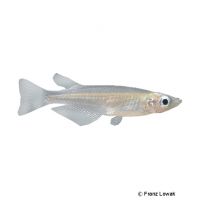White Japanese Ricefish (Oryzias latipes 'White')
| White Japanese Ricefish Oryzias latipes 'White' | |
|---|---|
| Name | White Japanese Ricefish |
| Name Lat. | Oryzias latipes 'White' |
| Synonym | White Medaka |
| Family | Ricefishes |
| Family lat. | Adrianichthyidae |
| Order | Needle Fishes |
| Order lat. | Beloniformes |
| Origin | Southeast Asia |
| Habitat | Streams, swamps, estuaries |
| Diet | Carnivore |
| pH | 6.5-8.5 |
| Behavior | Peaceful |
| Keeping | Group |
| Care Level | Easy |
| Reproduction | Egg scatterer |
| Breeding | Moderately difficult |
| Life Span | 3-5 years |
| Protection | No |
| Metric Units | |
| Size | 3.5 cm |
| Temperature | 16-24 °C |
| Hardness | 5-25 °dH |
| Aquarium | 50 l |
| US Units | |
| Size | 1.4" |
| Temperature | 61-75 °F |
| Hardness | 89-445 ppm |
| Aquarium | 15 gal |
Distribution and habitat
The white Japankärpfling is a breeding form. The Japankärpflinge are widespread from South Korea over Japan, the southeast of China, Taiwan to Laos and Vietnam. They live in very diverse habitats, such as estuaries and mangrove swamps with brackish water, forest streams and small rivers, ponds and floodplains with muddy-sandy bottoms and fallen leaves.
Maintenance
The aquarium should have a varied, partly dense planting, with shelters and hiding places (roots) and provide sufficient swimming space. A dark substrate covered with some foliage (e.g. sea almond leaves) and shaded light (floating plants) is ideal.
No ammonia, ammonium and nitrite should be detectable, the nitrate value should not exceed 100 mg/l. To ensure water quality and oxygen content, a filter and heater adapted to the aquarium size is required, as well as lighting for the species-appropriate day-night rhythm of the animals.
Diet
The diet consists of small live foods such as cyclops, daphnia, artemia and mosquito larvae, which are also readily accepted frozen, plus commercially available frozen special food mixtures supplemented with freeze-dried food. High-quality, protein-rich dry food (flakes, granules, micro-pellets) is also accepted without problems.
Only as much should be fed as is eaten immediately (in a maximum of 10 minutes). A regular and varied diet promotes health and increases resistance.
Behaviour and compatibility
These small and swimming fish are completely peaceful and should be kept in a group of at least 8-10 animals. They are well suited for any nano aquarium and can be easily socialized with other small and peaceful fish as well as shrimp (Caridina, Neocaridina).
Basically, only compatible fish species with similar demands on water conditions and water temperature should be socialized.
Sex dimorphism
The sexes are difficult to distinguish. The slimmer male has a larger and more pointed anal fin. With some experience, the sexes can be distinguished by their genital papilla, which is tubular in the male and bilobed in the female.
Reproduction and breeding
Mating usually takes place in the morning hours after an intense courtship, during which the male entwines the female. The eggs, 10-20 pieces, stick to the abdomen of the female (spawning cluster) and are stripped over water plants only after some time. This process may repeat for several days. After 1-3 weeks the fry hatch, which grow very slowly
During the first weeks the fry must be fed several times a day with infusoria or a commercial liquid rearing food for egg-laying fish. In community tanks breeding is hardly possible, because the fry are easy prey
Important
They are bred in some color forms. They show their most beautiful coloration by feeding with live food.
The foliage (sea almond tree, oak, etc.) not only provides cover, but when rotting promotes the development of microorganisms, which are a valuable secondary food source.
The well-being of the fish should be monitored regularly. Temperature should be checked daily, pH, hardness and nitrate levels at least every 14 days. Regular partial water changes are recommended, even when contaminant levels have not yet reached the upper limit. Sudden changes in water quality should be avoided. Newly introduced fish must be accustomed slowly to the water in the aquarium.
Further literature can be found in your pet store.
References
Text: petdata; Image: Franz Lowak
Source: BMELV (1998): Tierschutzgutachten - Haltung von Zierfischen (Süßwasser); BAENSCH & RIEHL (2004): Aquarien Atlas Bd. 2, Mergus Verlag; ENGELMANN (2005): Zootierhaltung - Tiere in menschlicher Obhut: Fische, Verlag Harri Deutsch
- Gemäß § 21 Abs. 5 Tierschutzgesetz idgF
